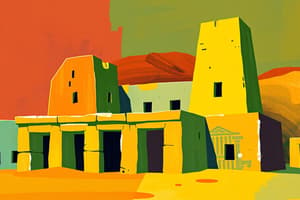Podcast
Questions and Answers
Which structures are associated with prehistoric architecture?
Which structures are associated with prehistoric architecture?
- Megaliths (correct)
- Pyramids
- Earthen mounds (correct)
- Stone circles (correct)
Ancient Egyptian architecture used load-bearing arches.
Ancient Egyptian architecture used load-bearing arches.
False (B)
What are the periods of architecture in ancient Egypt?
What are the periods of architecture in ancient Egypt?
The periods include the Old Kingdom, Middle Kingdom, and New Kingdom.
The famous structure in Athens is the __________.
The famous structure in Athens is the __________.
What was a characteristic feature of Gothic architecture?
What was a characteristic feature of Gothic architecture?
Who was a notable architect from the Renaissance period?
Who was a notable architect from the Renaissance period?
Match the following architectural styles with their characteristics:
Match the following architectural styles with their characteristics:
Flashcards are hidden until you start studying
Study Notes
Prehistoric and Neolithic Era (11,600 BCE - 3,500 BCE)
- Humans constructed earthen mounds, stone circles, megaliths, and monumental structures
- Examples include Stonehenge in the United Kingdom and Chauvet Cave in France
- Prehistoric builders moved earth and stone into geometric forms, creating the earliest human-made formations
- Prehistoric people looked to the heavens to imitate the sun and the moon, using circular shapes in their creations
Ancient Egypt (3,050 BCE - 900 BCE)
- Powerful rulers constructed monumental pyramids, temples, and shrines
- Examples include the Pyramids of Giza, which were feats of engineering
- Egyptian builders didn't use load-bearing arches; instead, columns were placed close together to support the heavy stone entablature above
- Columns were often brightly painted and elaborately carved, mimicking palms, papyrus plants, and other plant forms
- Egyptian art was functional, serving as a home for spirits or gods
Classical Era (850 BCE - CE 476)
- The Doric column was first developed in Greece
- Greece built elaborate temples and secular buildings with Ionic and Corinthian columns
- The Romans borrowed heavily from Greek styles, but their buildings were more highly ornamented
- The invention of concrete allowed the Romans to build arches, vaults, and domes
- Famous examples of Roman architecture include the Roman Colosseum and the Pantheon in Rome
Middle Ages
Byzantine Era (527 - 565 CE)
- After Constantine moved the Roman capital to Byzantium (now Istanbul, Turkey), Roman architecture evolved into a classically-inspired style using brick, domed roofs, and elaborate mosaics
- Eastern and Western traditions combined in the sacred buildings of the Byzantine period
- Buildings were designed with a central dome that eventually rose to new heights using refined engineering practices
- Byzantine art is concerned with religious expression and the translation of church theology into artistic terms
Romanesque Era (800 - 1200 CE)
- Churches and castles of the early Medieval period were constructed with thick walls and heavy piers
- The Basilica of St. Sernin in Toulouse, France is a good example of this transitional architecture
- Roman ideas reached far across Europe, even as the Roman Empire faded
Gothic Era (1100 - 1450 CE)
- Gothic architecture became characterized by elements that supported taller, more graceful architecture
- Innovations included pointed arches, flying buttresses, and ribbed vaulting
- Elaborate stained glass could take the place of walls
- Gothic architecture began mainly in France, influenced by Romanesque style and Moorish architecture in Spain
Renaissance Era (1400 - 1600 CE)
- A return to Classical ideas ushered in an "age of awakening" in Italy, France, and England
- Architects and builders were inspired by the carefully proportioned buildings of ancient Greece and Rome
- Italian Renaissance master Andrea Palladio helped awaken a passion for classical architecture
- Palladio's designs were in the manner of ancient designs, but his ideas did not imitate the Classical order of architecture
- The work of the Renaissance masters spread across Europe, inspiring architects in the Western world
Studying That Suits You
Use AI to generate personalized quizzes and flashcards to suit your learning preferences.




